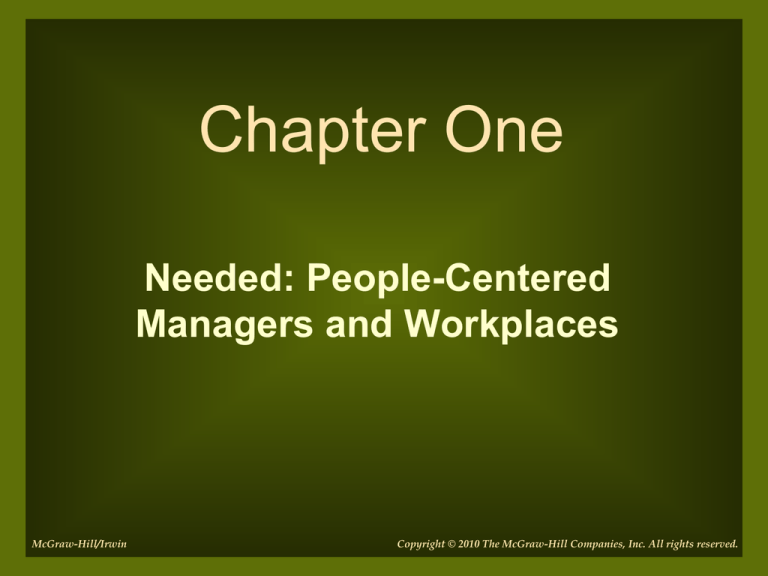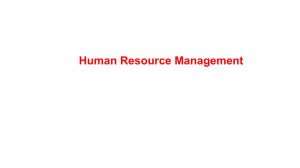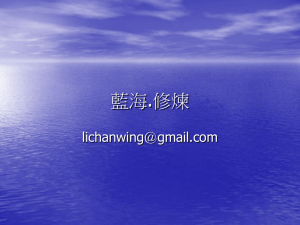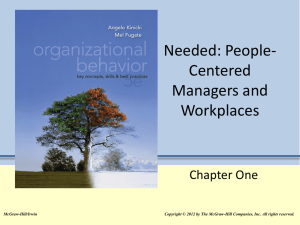
Chapter One
Needed: People-Centered
Managers and Workplaces
McGraw-Hill/Irwin
Copyright © 2010 The McGraw-Hill Companies, Inc. All rights reserved.
After reading the material in this chapter,
you should be able to:
• Identify at least four of Pfeffer’s people-centered
practices, and define the term management.
• Contrast McGregor’s Theory X and Theory Y
assumptions about employees.
• Explain the managerial significance of Deming’s
85-15 rule, and identify the four principles of
total quality management (TQM).
1-2
After reading the material in this chapter,
you should be able to:
• Contrast human capital and social capital, and
identify five measurable outcomes when
building human capital.
• Explain the impact of the positive psychology
movement on the field of organizational
behavior (OB).
• Define the term e-business, and explain at least
three practical lessons about effective
e-leadership in a virtual organization.
1-3
Pfeffer’s Seven People-Centered
Practices
• Job security
• Careful hiring
• Power to the people
• Generous pay for
performance
• Lots of training
• Less emphasis on
status
• Trust building
1-4
Question?
Jeremy, CEO of JNJ Computers, wants to build his
company around the people-centered practices.
Based on Pfeffer's research, which of these
practice(s) should he adopt?
A. Less emphasis on status
B. Generous pay for performance
C. Power to the people
D. All of these.
1-5
How Important are People
• Factors are a package deal – need to be
installed in a coordinated and systematic
manner
• Too many managers act counter to their
declarations that people are their most
important asset
• Undue emphasis on short-term profit
1-6
The 4-P Cycle of Continuous
Improvement
Figure 1-1
1-7
Managers Get Results
• Management
- process of working with and through others to
achieve organizational objectives efficiently
and ethically
• Today’s manager needs to creatively envision
and actively sell bold new directions in an ethical
and sensitive manner
1-8
A Skills Profile for Managers
• Typical manager’s day is a fragmented
collection of brief episodes
• Interruptions are commonplace while large
blocks of time for
planning are not
1-9
Skills & Best Practices:
The Effective Manager’s Skill Profile
1. Clarifies goals and objectives for
everyone involved.
2. Encourages participation, upward
communication, and suggestions.
3. Plans and organizes for an orderly
workflow.
1-10
Skills & Best Practices:
The Effective Manager’s Skill Profile
4. Has technical and administrative expertise to
answer organization-related questions.
5. Facilitates work through team building, training,
coaching, and support.
6. Provides feedback honestly and constructively.
7. Keeps things moving by relying on schedules,
deadlines, and helpful reminders.
1-11
Skills & Best Practices:
The Effective Manager’s Skill Profile
8. Controls details without being overbearing.
9. Applies reasonable pressure for goal
accomplishment.
10. Empowers and delegates key duties to others
while maintaining goal clarity and commitment.
11. Recognizes good performance with rewards
and positive reinforcement.
1-12
Three Lessons for Managers
1. Dealing effectively with people is what
management is all about.
2. Managers with high skills mastery tend to
have better subunit performance and
employee morale
3. Effective female and male managers do
not have significantly different skill
profiles
1-13
21st-Century Managers
• Teams are pushing aside the individual
• Command-and-control management is
giving way to participative management
and empowerment
• Ego-centered leaders are being replaced
by customer-centered leaders
• Employees are being viewed as internal
customers
1-14
Evolution of 21st Century
Managers
1-15
The Field of Organizational Behavior
• Organizational Behavior
- Interdisciplinary field dedicated to better
understanding and managing people at work
1-16
The Human Relations Movement
• Legalization of union-management
collective bargaining
• Behavioral scientist called more attention
to the human factor
• Elton Mayo – Western Electric Hawthorne
study
1-17
The Hawthorne Legacy
• Interviews do not support initial conclusions
about positive effect of supportive
supervision
• Money, fear of unemployment, managerial
discipline and high quality raw materials
were responsible for high output
1-18
McGregor’s Theory Y
• Theory X assumptions
- pessimistic and negative, typical of how
managers traditionally perceived employees
1-19
McGregor’s Theory Y
• Theory Y
- believed managers could accomplish more
through others by viewing them as selfenergized, committed, responsible, and
creative beings
1-20
Question?
As a production manager of Great Golf Products
(GGP), Lorena believes that her employees are
capable of self-direction and self-control. She
also believes that they are committed to
Titanium's objectives since they are rewarded for
doing so. Lorena can be described as a:
A. Theory X manager.
B. Theory Z manager.
C. Futuristic manager.
D. Theory Y manager.
1-21
What is TQM?
• Total Quality Management
- An organizational culture dedicated to training,
continuous improvement, and customer
satisfaction
1-22
The Deming Legacy
• Formal training in statistical process control
and techniques
• Helpful leadership, rather than order giving
and punishment
• Elimination of fear so employees will feel
free to ask questions
• Teamwork
• Elimination of barriers to good
workmanship
1-23
What is TQM?
Principles of TQM
1.Do it right the first time to eliminate costly
rework.
2.Listen to and learn from customers and
employees.
3.Make continuous improvement an
everyday matter.
4.Build teamwork, trust and mutual respect.
1-24
Question?
John tries to make continuous improvement
on his production process each week. This
follows the philosophy of _________.
A. Administrative management
B. Bureaucracy
C. Total quality management
D. Contingency management
1-25
The Contingency Approach to
Management
• Contingency Approach
- Using management concepts and techniques
in a situationally appropriate manner, instead
of trying to rely on “one best way”
1-26
Figure 1-2
1-27
The Age of Human and Social
Capital
• Human Capital
- The productive potential of one’s knowledge
and actions
- A present or future employee with the right
combination of knowledge, skills, and
motivation to excel
1-28
Five Human Capital
Outcomes Defined
SOURCE: L Bassi and D McMurrer, “Developing Measurement Systems for Managing in the
Knowledge Era,” Organizational Dynamics, no. 2, 2005, Table 2, p 190.
1-29
Question?
• Terry supervises the stamping department
for Elkay. He has a great reputation for
developing and training people. This is an
example of __________.
A. Learning capacity
B. Workforce optimization
C. Talent engagement
D. Knowledge accessibility
1-30
The Age of Human and Social
Capital
• Social capital
- The productive potential of strong, trusting,
and cooperative relationships
1-31
The Positive Psychology Movement
• Recommends focusing on human
strengths and potential as a way to prevent
mental and behavioral problems and to
improve the general quality of life
1-32
Positive Organizational Behavior
• Positive
Organizational
Behavior (POB)
• the study and
improvement of
employees’ positive
attributes and
capabilities
Read Jean-Pierre Neveu’s
article on Positive
Organizational Behavior
1-33
Luthans’s CHOSE Model
Of Key POB Dimensions
SOURCE: From The Academy of Management Executive: The Thinking Manager’s Source by F.
Luthans. Copyright © 2002 by Academy of Management. Reproduced with permission of
Academy of Management via Copyright Clearance Center.
1-34
Question?
Griff believes that he can successfully
perform any assignment that his supervisor
gives him. What POB dimension does he
exhibit?
A. Confidence
B. Hope
C. Optimism
D. Emotional intelligence
1-35
The Internet and E-Business Revolution
• E-business
- running the entire business via the
Internet
• Employees can collaborate online, whether
developing new products, creating
marketing plans,
or resolving billing
problems
1-36
Question?
Thinkgeek.com only has a business
presence on the web. This is an example
of a(n) __________.
A. “Brick & Click”
B. “Click & Mortar”
C. E-business
D. Retailer
1-37
Supplemental Slides
• Slides 39-45 contain extra non-text
examples to integrate and enhance
instructor lectures
- Slide 39: The Value of Management
- Slides 40-41: People-Centered Examples
- Slide 42-43: Tips for Becoming a People
Developer
- Slide 44-45: Video discussion slide
1-38
The Value of Management
20
18
16
14
12
10
8
6
4
2
0
19.4
8
Hi Morale
David Sirota, founder Sirota Research
Low/Mod
Morale
% inc in stock
price
• "The success of an
organization is dependent
upon the competence of
senior management and the
morale of the workforce,“ ~
• “How do you keep
management from
destroying the
workforce?”
Source: Study Sees Link Between Morale and Stock Price, HR Executive Online, March 6, 2006
1-39
People-Centered Examples
• Herb Kelleher, Southwest Airlines
- “Respect people for who they are, not for what
their titles are.”
• Clayton Christensen, Harvard Business
School
- “You can learn from anyone.”
1-40
People-Centered Examples
• George Zimmer, Men’s Wearhouse
- Happy employees attract loyal customers.
- Every 5 years full time employees receive a
three-week paid sabbatical on top of their
regular vacations
• Jim Sinegal, Costco
- Good starting pay, 94% health care costs
1-41
Tips for Becoming a People
Developer
1) Motivate people by convincing them to take
charge of their own development
2) Integrate the individual’s development plan with
the formal performance-improvement process
3) Rely on more training for developing your
people
4) Delegate whenever possible to both lighten
your load and to challenge and develop your
people
1-42
Tips for Becoming a People
Developer
5) Really get to know your people and their
career aspirations
6) Have at least a three-year development
path in mind when interviewing new
people
7) Make sure people who take charge of
their own development are creatively
rewarded
1-43
Video Case: Starbucks
• Why does Starbucks view its social responsibility
activities not as an expense or requirement, but
rather as an “enlightened self-interest”?
• What is the benefit for Starbucks in assisting
Latin American farmers in obtaining financing to
pay their pickers?
• Why is Starbucks so interested in protecting the
interests of the farmers who supply their coffee aren’t there others they could buy from?
1-44
Video: Pike Place Fish Market
• What does it mean at Pike Place Fish to be world
famous? Why does it take some new employees months
to understand this concept?
• What role does organizational culture play in Pike Place
Fish’s quest to be world famous? Why are other firms
such as Coffee Bean & Tea Leaf adopting the “fish”
philosophy?
• How does Pike Place Fish create the context for workers
to reach their maximum potential? What role does
socialization and mentoring play in creating and nurturing
this atmosphere?
1-45






